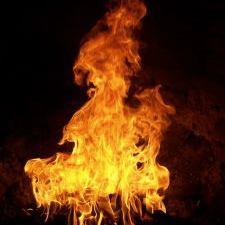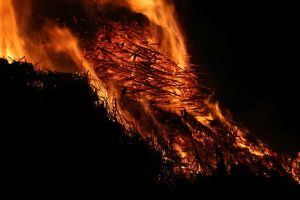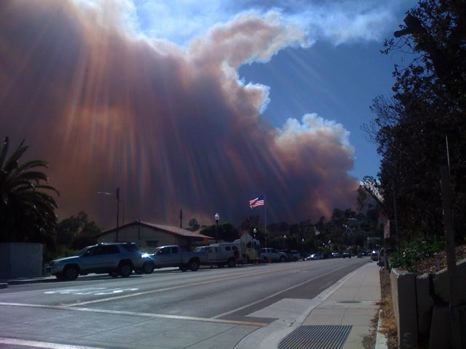 A massive wildfire raging near Los Angeles has turned parts of the city into a smoke-filled twilight zone and is threatening to damage sensitive radio, television and astronomical equipment that lies in its path.
A massive wildfire raging near Los Angeles has turned parts of the city into a smoke-filled twilight zone and is threatening to damage sensitive radio, television and astronomical equipment that lies in its path.
The blaze, dubbed the Station Fire, is burning up large tracts of the Angeles National Forest which is located in the San Gabriel mountains to the northwest of downtown L.A.
Already one of the biggest wildfires this year, what will the Station Fire mean for travel to Los Angeles?
The San Gabriel Mountains are popular with campers and hikers, most of whom have already been safely evacuated.
 Low humidity and difficult terrain have made it difficult for firefighters to control the inferno, which doubled in size Sunday night and has so far burned over 86,000 acres. According to L.A. County Fire Department officials, the fire is only 5 percent contained at this point.
Low humidity and difficult terrain have made it difficult for firefighters to control the inferno, which doubled in size Sunday night and has so far burned over 86,000 acres. According to L.A. County Fire Department officials, the fire is only 5 percent contained at this point.
The Station Fire, which was so named because it began on Wednesday near a ranger station in the middle of the forest, has branched out in three directions: to the north, southeast and west.
Previous California wildfire coverage:
- Wildfire Stunts Tourism in Santa Barbara
- California Wildfire Crisis: Who Helped, Who Balked
- California Wildfires Rage (Nov. 2008)
The western flank of the fire is currently headed toward Mt. Wilson, the 5,700-foot peak which towers over the northern part of L.A. and houses a famous astronomical observatory as well as dozens of radio and television transmission towers used by local media and law enforcement.
Firefighters have set up operations around the observatory and the transmission equipment in order to defend the structures from the flames. The fire has not advanced on the peak as quickly as first anticipated, which has given firefighters more time to clear brush and create a fire line around the area.
 Some media reports have stated that the area also contains transmission equipment used by the FBI, the CIA and local air traffic control services. We were unable to confirm with the FBI or CIA, but Mike Fergus, a spokesman for the FAA, said the agency has no air traffic control equipment on Mt. Wilson.
Some media reports have stated that the area also contains transmission equipment used by the FBI, the CIA and local air traffic control services. We were unable to confirm with the FBI or CIA, but Mike Fergus, a spokesman for the FAA, said the agency has no air traffic control equipment on Mt. Wilson.
He did however explain that the FAA uses some communication lines located on the peak, but the agency has already re-routed calls to lines located in other areas.
The Mt. Wilson Observatory, which was founded in 1904, houses a 60-inch telescope which at one time was the largest in the world. Renowned scientist Edwin Hubble also used the observatory, and his discoveries there led to the development of the “Big Bang” theory of the creation of the universe.
 The enormous blaze has sent an ominous grey cloud shooting thousands of feet into the atmosphere, which is visible from all over southern California. Almost non-existent winds and an area of atmospheric high pressure over the city have forced much of the smoke close to the ground, which has resulted in extremely hazardous air quality.
The enormous blaze has sent an ominous grey cloud shooting thousands of feet into the atmosphere, which is visible from all over southern California. Almost non-existent winds and an area of atmospheric high pressure over the city have forced much of the smoke close to the ground, which has resulted in extremely hazardous air quality.
Any air quality reading above 100 is considered unhealthful, but officials at the South Coast Air Quality Management District said that the Los Angeles air quality index was recorded at a shocking 398 on Monday.
Many L.A. public schools were scheduled to begin the fall term on Monday but some opted to stay closed out of concern for the safety of the children. Others canceled athletic activities or forced students to remain indoors. Those who suffer from asthma, emphysema or other respiratory disorders have been advised to stay indoors and not engage in any strenuous activity.
Many L.A.-area freeways including Interstate 5 through the San Fernando Valley and State Route 14 through Acton have very poor visibility and motorists are advised to drive with caution.
Visitors planning to go to popular tourist attractions near the fire zone such as Universal Studios may want to head out toward coastal areas instead, which have not been adversely affected by the smoke. Hikers and bikers are advised to avoid the San Gabriel mountains entirely and head to alternative areas such as the Santa Monica mountains.
Three other fires are also burning around southern California, including the Oak Glen Fire (or Yucaipa Fire) which is threatening the state’s most prominent apple-growing region. Much of the area has been experiencing triple-digit temperatures and tinder-dry conditions. However, none of the other fires are as large or dangerous as the Station Fire, and most are well-contained at this point.
By Karen Elowitt for PeterGreenberg.com.
Related links: Reuters, The Telegraph (UK), Los Angeles Times, San Jose Mercury News
Learn more:












